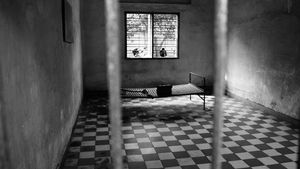JAKARTA - Foreign tourists are again making trouble by taking irresponsible actions against historical tourist attractions in Italy.
Most recently, the 460-year-old Vasari Corridor, a beautiful alley on the riverbank connected to Florence's famous Uffizi Gallery, was filled with graffiti related to the football team in the early hours of August 23.
Perpetrators of alleged acts of vandalism, according to the Italian military police branch of the Carabinieri in Florence, are two German tourists among the 11 students staying at the inn in the city center.
"The Florence Carabinieri Operations Unit and Uffizi Carabinieri Station analyzed surveillance video footage, successfully identifying two people who at 5.20 am, damaged a very important art site," said Carabinieri Florentine in a statement to CNN, as quoted September 15.
The two suspects, aged 20 and 21, were monitored after they used spray paint to write on the ancient building, Carabinieri said.
The shelter where they were staying was raided based on a search warrant. Evidence of two cans of black spray paint and paint coatings were found.
Authorities said they are now comparing fingerprints of paint cans with 11 students who were all questioned about the matter.
Meanwhile, Italy's Ministry of Culture said the vandalism led to an improvement of 10,000 euros and work had to be carried out under the supervision of 24-hour armed guards.
Italian Culture Minister Gennaro Sangiuliano thanked officials for their hard work in tracking down the culprits.
"I would like to thank the Carabinieri for immediately identifying the suspected perpetrators of the Vasari Corridor in Florence. Actions like this should not be left alone. Now justice has been upheld," he said in a statement.
It is known that the one-kilometer Vasari Corridor was built by Italian painter and architect Renaisans Giorgio Vasari, in less than nine months in 1565.
This was intended as a secret closed route for the leader of theagmad dynasty at the time, Cosimo I de'Medici, between private family homes in Taman Boboli to what is now the Uffizi museum, but at that time was the center of government power.
This flyover stretches along the Arno River, crosses the roofs of the city center of Florence and crosses the ancient Ponte Vecchio bridge. It also passes through the Basilica of Santa Felicita before reaching the Boboli park where the Dynasty lives.
The corridor was restored in 1973, but closed to the public in 2016 due to security concerns at the evacuation exit. The Corridor has been working since 2019 to reopen to the public.
اقرأ أيضا:
The move adds to a row of despicable tourist actions in Italy over the past year, from the destruction of the ancient Colosseum in Rome to swimming in UNESCO's protected lagoon in Venice. Tourists also threw electric scooters and rode Masareti down the Spanish Steps in Rome.
Director Uffizi Eike Schmidt condemned the despicable act, calling for an iron hand sentence rather than a symbolic punishment, which is often imposed on poor-behaved tourists, especially to avoid the issue of their extradition.
Often tourists who behave poorly are subject to small fines and are prohibited from returning to the city where they commit crimes. Schmidt calls for prison sentences for violators of any cultural heritage site.
The English, Chinese, Japanese, Arabic, and French versions are automatically generated by the AI. So there may still be inaccuracies in translating, please always see Indonesian as our main language. (system supported by DigitalSiber.id)


















